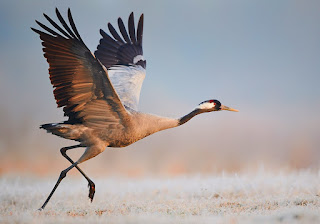
The crane appears to be a close relative of storks and herons, despite the fact that they are not genetically related. Cranes are classified into four genera, with a total of 15 species. Except for Antarctica and South America, these birds can be found on all continents. Crane prefers to live in marshes and on the plains.
They have the body shape of herons and egrets, but they are heavier. The number of all crane species has decreased dramatically in recent years as a result of accelerated habitat loss and pet trade. The endangered species list includes the Whooping Crane, Florida Sandhill Crane, Siberian Crane, and Mississippi Sandhill Crane.
Cranes range in size from 8.8 to 26.5 pounds in weight and 3 to 7 feet in length, depending on the species. Demoiselle Cranes are the smallest crane species, Sarus Cranes are the tallest, and Red-crowned Cranes are the heaviest.
Cranes are distinguished by their long necks and straight beaks.
Cranes feed opportunistically. That means they’ll eat whatever they can find in their environment.
Amphibians, fish, insects, and small rodents, as well as seed, berries, and various plants, are frequently on their menu.
Cranes are social birds that congregate in large groups known as flocks.
Loud sounds are used to establish communication within the flock. They make a wide range of sounds, including alarm calls that alert other birds in the flock to a potential threat. Cranes communicate through body language as well.
Some crane species live on a single territory year round, while others migrate seasonally (those that live in temperate climate). During migration, migratory species can travel up to 10,000 miles.
Some crane species can travel up to 500 miles per day in search of food.
Cranes from Europe and Asia can fly up to 32 800 feet. That is a world record for birds.
Crane relies on the wind and warm air columns to fly at the appropriate height and length.
Crane mating season varies according to species. Between April and May, migratory cranes mate. From December to March, non-migratory species mate.
Cranes are monogamous birds (one couple mate for a lifetime). Mating rituals are complicated dances that include fast foot movements, jumps, stretching, and bowing.
Nests are constructed in marshy areas. The female lays two eggs, which hatch after about 30 days.
Both parents care for the chicks for up to ten months after hatching. Chicks develop the same plumage as their parents 2 to 4 months after hatching.
Some crane species’ chicks sleep in a standing position. Between the ages of 3 and 5 years, young birds reach sexual maturity.
In the wild, the crane has an average lifespan of 20 to 30 years. The oldest known crane was the Siberian Crane, which lived in captivity for 83 years.










I wanted to express my deep gratitude for the incredible content you consistently provide on your blog. Your ability to convey complex ideas in a clear and engaging manner is truly remarkable. You’ve expanded my horizons and sparked my curiosity in ways I never thought possible. Thank you for being a constant source of intellectual nourishment.